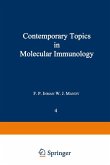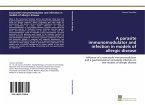- Broschiertes Buch
- Merkliste
- Auf die Merkliste
- Bewerten Bewerten
- Teilen
- Produkt teilen
- Produkterinnerung
- Produkterinnerung
Our motivation for putting together this book was the need for a single source reference that could be used as an introduction to cell-mediated cytotoxicity for newcomers to this field, such as students and fellows beginning work in our laboratories. At present no such book is available, and we felt that it would be useful as a teaching tool and as a way of conveying our enthusiasm about recent progress in the cytotoxicity field to our colleagues in allied areas. It was with some hesitation that we approached our colleagues with the proposal for this book, and we were pleased to find them very…mehr
Andere Kunden interessierten sich auch für
![Trends in Neuroimmunology Trends in Neuroimmunology]() Maria Giovanna MarrosuTrends in Neuroimmunology38,99 €
Maria Giovanna MarrosuTrends in Neuroimmunology38,99 €![Contemporary Topics in Molecular Immunology Contemporary Topics in Molecular Immunology]() F. P. InmanContemporary Topics in Molecular Immunology39,99 €
F. P. InmanContemporary Topics in Molecular Immunology39,99 €![A parasite immunomodulator and infection in models of allergic disease A parasite immunomodulator and infection in models of allergic disease]() Corinna SchnöllerA parasite immunomodulator and infection in models of allergic disease35,99 €
Corinna SchnöllerA parasite immunomodulator and infection in models of allergic disease35,99 €![Angiogenesis Angiogenesis]() SteinerAngiogenesis39,99 €
SteinerAngiogenesis39,99 €![Introduction to Virology Introduction to Virology]() K. SmithIntroduction to Virology75,99 €
K. SmithIntroduction to Virology75,99 €![Temporal Aspects of Therapeutics Temporal Aspects of Therapeutics]() Temporal Aspects of Therapeutics39,99 €
Temporal Aspects of Therapeutics39,99 €![Histocompatibility Antigens Histocompatibility Antigens]() Histocompatibility Antigens39,99 €
Histocompatibility Antigens39,99 €-
-
-
Our motivation for putting together this book was the need for a single source reference that could be used as an introduction to cell-mediated cytotoxicity for newcomers to this field, such as students and fellows beginning work in our laboratories. At present no such book is available, and we felt that it would be useful as a teaching tool and as a way of conveying our enthusiasm about recent progress in the cytotoxicity field to our colleagues in allied areas. It was with some hesitation that we approached our colleagues with the proposal for this book, and we were pleased to find them very supportive of the idea and willing to participate. We thought it important to broaden the scope of the book to include historical, molecular, cell biological, and clinical aspects of cell-mediated cytotoxicity. To our knowledge this is the first book on cell-mediated cytotoxicity with such a broad scope. Historically, studies on cellular cytotoxicity were part of cellular immunology from its origin. One development of tremendous import was the advent of the 51 Cr assay, which allowed this arm of the immune response to be measured easily and quantitatively. Thus, a readout of this effector pathway is available within a few hours; other immune effector functions can take days or even longer to assay, and the assays are often less quantitative.
Produktdetails
- Produktdetails
- Verlag: Birkhäuser / Birkhäuser Boston / Springer, Basel
- Artikelnr. des Verlages: 978-1-4684-6816-8
- Softcover reprint of the original 1st ed. 1993
- Seitenzahl: 544
- Erscheinungstermin: 22. März 2012
- Englisch
- Abmessung: 254mm x 178mm x 30mm
- Gewicht: 1011g
- ISBN-13: 9781468468168
- ISBN-10: 1468468162
- Artikelnr.: 39687987
- Herstellerkennzeichnung
- Springer Nature c/o IBS
- Benzstrasse 21
- 48619 Heek
- Tanja.Keller@springer.com
- Verlag: Birkhäuser / Birkhäuser Boston / Springer, Basel
- Artikelnr. des Verlages: 978-1-4684-6816-8
- Softcover reprint of the original 1st ed. 1993
- Seitenzahl: 544
- Erscheinungstermin: 22. März 2012
- Englisch
- Abmessung: 254mm x 178mm x 30mm
- Gewicht: 1011g
- ISBN-13: 9781468468168
- ISBN-10: 1468468162
- Artikelnr.: 39687987
- Herstellerkennzeichnung
- Springer Nature c/o IBS
- Benzstrasse 21
- 48619 Heek
- Tanja.Keller@springer.com
Section I: Introduction and Overview.- I Introductory Remarks.- 2 T-Cell-Mediated Cytotoxicity: A Historical Note.- 3 Overview of CTL-Target Adhesion and Other Critical Events in the Cytotoxic Mechanism.- Section II: Target Cell Recognition.- 4 ?? T-Cell Receptor Repertoires Among Cytotoxic and Helper T Lymphocytes.- 5 Class I MHC/Peptide/?2-Microglobulin Interactions: The Basis of Cytotoxic T-Cell Recognition.- 6 The Role of CD8-Class I Interactions in CTL Function.- 7 Interactions Between CD2 and T-Cell Receptor Isoforms in CTL Function.- 8 Triggering Structures on NK Cells.- 9 Targeted Cellular Cytotoxicity.- Section III: Generation of Cytotoxic Cells.- 10 Immunobiology and Molecular Characteristics of Peritoneal Exudate Cytotoxic T Lymphocytes (PEL), Their In Vivo IL-2 Dependent Blasts and IL-2 Independent Cytolytic Hybridomas.- 11 Regulatory Effects of Cytokines on the Generation of CTL and LAK Cells.- 12 IL-2-Independent Activation of LAK Cells by a Heterodimeric Cytokine, Interleukin-12.- 13 Immunobiology of ?2-Microglobulin-Deficient Mice.- Section IV: Molecular Mechanisms of Cellular Cytotoxicity.- 14 The Granule Exocytosis Model for Lymphocyte Cytotoxicity and Its Relevance to Target Cell DNA Breakdown.- 15 Subpopulations of Cytotoxic T Lymphocytes with Different Cytotoxic Mechanisms.- 16 Multiple Lytic Pathways in Cytototoxic T Lymphocytes.- 17 Properties of Cytotoxicity Mediated by CD4+, Perforin-Negative T-Lymphocyte Clones.- 18 Direct Contact of Cytotoxic T Lymphocyte Receptors with Target Cell Membrane Determinants Induces a Prelytic Rise of [Ca2+]1 in the Target That Triggers Disintegration.- 19 Target Cell Events Initiated by T-Cell Attack.- 20 Apoptosis and Cytotoxic T Lymphocytes.- 21 Molecular Mechanisms of Lymphocyte Cytotoxicity.- Section V:Granule Proteases.- 22 Subtractive and Differential Molecular Biology Approaches to Molecules Preferentially Expressed in Cytotoxic and Other T Cells.- 23 Structure and Possible Functions of Lymphocyte Granzymes.- 24 The Role of Granzyme A in Cytotoxic Lymphocyte-Mediated Lysis.- 25 The Granzyme A Gene: A Marker for Cytolytic Lymphocytes In Vivo.- 26 Molecular Analysis and Possible Pleiotropic Function(s) of the T Cell-Specific Serine Proteinase-1 (TSP-1).- 27 Serine Protease Control of Lymphocyte-Mediated Cytolysis.- Section VI: Alternative Mechanisms of Cytolysis.- 28 Possible Role of Extracellular ATP in Cell-Cell Interactions Leading to CTL-Mediated Cytotoxicity.- 29 Cell-Permeabilizing Properties of Extracellular ATP in Relation to Lymphocyte-Mediated Cytotoxicity.- 30 The Role of Free Fatty Acids in CTL-Target Cell Interactions.- Section VII: Biochemical and Immunopharmacological Manipulations of Cytotoxic Cells.- 31 Identification of Protein Kinases and Protein Phosphatases Involved in CTL Effector Functions. "ON" and "OFF" Signaling and Immunopharmacological Implications.- 32 Cytolytic Granules as Targets for Immunosuppressive Therapy: Selective Ablation of CTL by Leucyl-Leucine Methyl Ester.- Section VIII: Functions of Cytotoxic Cells in Vivo.- 33 Role of CD8+?? T Cells in Respiratory Infections Caused by Sendai Virus and Influenza Virus.- 34 CD4+ and CD8+ Cytolytic T Lymphocyte Recognition of Viral Antigens.- 35 Can CTL Control Virus Infections Without Cytolysis? The Prelytic Halt Hypothesis.- 36 Immunologic Control of Toxoplasma Gondii Infection by CD8+ Lymphocytes: A Model for Class I MHC- Restricted Recognition of Intracellular Parasites.- 37 Antigen-Specific Suppression of Antibody Responses by Class II MHC-Restricted CTL.- 38 TheImmunosenescence of Cytolytic T Lymphocytes (CTL): Reduction of Pore-Forming Protein and Granzymc Levels.- 39 Bone Marrow Graft Rejection as a Function of TNK Cells.- 40 Class I MHC Antigens and the Control of Virus Infections by NK Cells.- 41 Clinical Trials of Immunotherapy of Cancer Utilizing Cytotoxic Cells.- Section IX: Macrophage-Mediated Cytotoxicity.- 42 Macrophage-Mediated Cytotoxicity.- Section X: Methods.- 43 The 51Cr-Release Assay for CTL-Mediated Target Cell Lysis.- 44 DNA Fragmentation and Cytolysis Assayed by 3H-Thymidine.- 45 The JAM Test: An Assay of Cell Death.- 46 Target Cell Detachment Assay.- 47 Protocol for Assaying CTL Activity Against Toxoplasma gondii.- 48 Granule Exocytosis Assay of CTL Activation.- 49 Measurement of Cytolysin Hemolytic Activity.- 50 SPDP Crosslinking of Antibodies to Form Heteroconjugates Mediating Redirected Cytotoxicity.- 51 Derivatization of Cells with Antibody.- 52 Mixed Lymphocyte Culture for the Generation of Allospecific CTL.- 53 Generation of CD4+ and CD8+ Antiinfluenza CTL and Assay of In Vitro Cytotoxicity.- 54 Generation of Antigen-Specific M urine CTL Under Weakly Immunogenic Conditions.- 55 Commercial Liposomes and Electroporation Can Deliver Soluble Antigen for Class I Presentation in CTL Generation.- 56 Stimulation of CTLs on Antibody-Coated Plates.- 57 CTL Recognition of Purified MHC Antigens and Other Cell Surface Ligands.- 58 Use of Protease Inhibitors as Probes for Biological Functions: Conditions, Controls, and Caveats.- 59 The Murine T Cell-Specific Serine Proteinase-1: Cleavage Activity on Synthetic and Natural Substrates.- 60 Detection of Specific mRNAs by In Situ Hybridization.
Section I: Introduction and Overview.- I Introductory Remarks.- 2 T-Cell-Mediated Cytotoxicity: A Historical Note.- 3 Overview of CTL-Target Adhesion and Other Critical Events in the Cytotoxic Mechanism.- Section II: Target Cell Recognition.- 4 ?? T-Cell Receptor Repertoires Among Cytotoxic and Helper T Lymphocytes.- 5 Class I MHC/Peptide/?2-Microglobulin Interactions: The Basis of Cytotoxic T-Cell Recognition.- 6 The Role of CD8-Class I Interactions in CTL Function.- 7 Interactions Between CD2 and T-Cell Receptor Isoforms in CTL Function.- 8 Triggering Structures on NK Cells.- 9 Targeted Cellular Cytotoxicity.- Section III: Generation of Cytotoxic Cells.- 10 Immunobiology and Molecular Characteristics of Peritoneal Exudate Cytotoxic T Lymphocytes (PEL), Their In Vivo IL-2 Dependent Blasts and IL-2 Independent Cytolytic Hybridomas.- 11 Regulatory Effects of Cytokines on the Generation of CTL and LAK Cells.- 12 IL-2-Independent Activation of LAK Cells by a Heterodimeric Cytokine, Interleukin-12.- 13 Immunobiology of ?2-Microglobulin-Deficient Mice.- Section IV: Molecular Mechanisms of Cellular Cytotoxicity.- 14 The Granule Exocytosis Model for Lymphocyte Cytotoxicity and Its Relevance to Target Cell DNA Breakdown.- 15 Subpopulations of Cytotoxic T Lymphocytes with Different Cytotoxic Mechanisms.- 16 Multiple Lytic Pathways in Cytototoxic T Lymphocytes.- 17 Properties of Cytotoxicity Mediated by CD4+, Perforin-Negative T-Lymphocyte Clones.- 18 Direct Contact of Cytotoxic T Lymphocyte Receptors with Target Cell Membrane Determinants Induces a Prelytic Rise of [Ca2+]1 in the Target That Triggers Disintegration.- 19 Target Cell Events Initiated by T-Cell Attack.- 20 Apoptosis and Cytotoxic T Lymphocytes.- 21 Molecular Mechanisms of Lymphocyte Cytotoxicity.- Section V:Granule Proteases.- 22 Subtractive and Differential Molecular Biology Approaches to Molecules Preferentially Expressed in Cytotoxic and Other T Cells.- 23 Structure and Possible Functions of Lymphocyte Granzymes.- 24 The Role of Granzyme A in Cytotoxic Lymphocyte-Mediated Lysis.- 25 The Granzyme A Gene: A Marker for Cytolytic Lymphocytes In Vivo.- 26 Molecular Analysis and Possible Pleiotropic Function(s) of the T Cell-Specific Serine Proteinase-1 (TSP-1).- 27 Serine Protease Control of Lymphocyte-Mediated Cytolysis.- Section VI: Alternative Mechanisms of Cytolysis.- 28 Possible Role of Extracellular ATP in Cell-Cell Interactions Leading to CTL-Mediated Cytotoxicity.- 29 Cell-Permeabilizing Properties of Extracellular ATP in Relation to Lymphocyte-Mediated Cytotoxicity.- 30 The Role of Free Fatty Acids in CTL-Target Cell Interactions.- Section VII: Biochemical and Immunopharmacological Manipulations of Cytotoxic Cells.- 31 Identification of Protein Kinases and Protein Phosphatases Involved in CTL Effector Functions. "ON" and "OFF" Signaling and Immunopharmacological Implications.- 32 Cytolytic Granules as Targets for Immunosuppressive Therapy: Selective Ablation of CTL by Leucyl-Leucine Methyl Ester.- Section VIII: Functions of Cytotoxic Cells in Vivo.- 33 Role of CD8+?? T Cells in Respiratory Infections Caused by Sendai Virus and Influenza Virus.- 34 CD4+ and CD8+ Cytolytic T Lymphocyte Recognition of Viral Antigens.- 35 Can CTL Control Virus Infections Without Cytolysis? The Prelytic Halt Hypothesis.- 36 Immunologic Control of Toxoplasma Gondii Infection by CD8+ Lymphocytes: A Model for Class I MHC- Restricted Recognition of Intracellular Parasites.- 37 Antigen-Specific Suppression of Antibody Responses by Class II MHC-Restricted CTL.- 38 TheImmunosenescence of Cytolytic T Lymphocytes (CTL): Reduction of Pore-Forming Protein and Granzymc Levels.- 39 Bone Marrow Graft Rejection as a Function of TNK Cells.- 40 Class I MHC Antigens and the Control of Virus Infections by NK Cells.- 41 Clinical Trials of Immunotherapy of Cancer Utilizing Cytotoxic Cells.- Section IX: Macrophage-Mediated Cytotoxicity.- 42 Macrophage-Mediated Cytotoxicity.- Section X: Methods.- 43 The 51Cr-Release Assay for CTL-Mediated Target Cell Lysis.- 44 DNA Fragmentation and Cytolysis Assayed by 3H-Thymidine.- 45 The JAM Test: An Assay of Cell Death.- 46 Target Cell Detachment Assay.- 47 Protocol for Assaying CTL Activity Against Toxoplasma gondii.- 48 Granule Exocytosis Assay of CTL Activation.- 49 Measurement of Cytolysin Hemolytic Activity.- 50 SPDP Crosslinking of Antibodies to Form Heteroconjugates Mediating Redirected Cytotoxicity.- 51 Derivatization of Cells with Antibody.- 52 Mixed Lymphocyte Culture for the Generation of Allospecific CTL.- 53 Generation of CD4+ and CD8+ Antiinfluenza CTL and Assay of In Vitro Cytotoxicity.- 54 Generation of Antigen-Specific M urine CTL Under Weakly Immunogenic Conditions.- 55 Commercial Liposomes and Electroporation Can Deliver Soluble Antigen for Class I Presentation in CTL Generation.- 56 Stimulation of CTLs on Antibody-Coated Plates.- 57 CTL Recognition of Purified MHC Antigens and Other Cell Surface Ligands.- 58 Use of Protease Inhibitors as Probes for Biological Functions: Conditions, Controls, and Caveats.- 59 The Murine T Cell-Specific Serine Proteinase-1: Cleavage Activity on Synthetic and Natural Substrates.- 60 Detection of Specific mRNAs by In Situ Hybridization.









